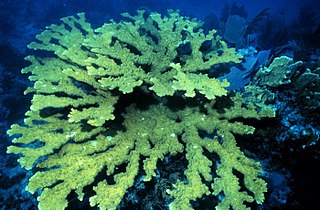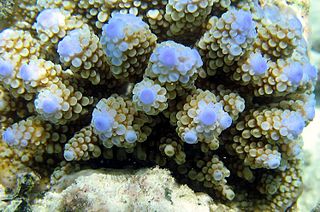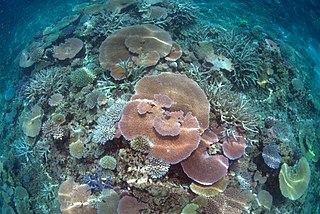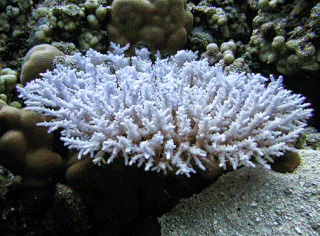
Acropora is a genus of small polyp stony coral in the phylum Cnidaria. Some of its species are known as table coral, elkhorn coral, and staghorn coral. Over 149 species are described. Acropora species are some of the major reef corals responsible for building the immense calcium carbonate substructure that supports the thin living skin of a reef.

The staghorn coral is a branching, stony coral with cylindrical branches ranging from a few centimetres to over two metres in length and height. It occurs in back reef and fore reef environments from 0 to 30 m depth. The upper limit is defined by wave forces, and the lower limit is controlled by suspended sediments and light availability. Fore reef zones at intermediate depths 5–25 m (16–82 ft) were formerly dominated by extensive single-species stands of staghorn coral until the mid-1980s. This coral exhibits the fastest growth of all known western Atlantic fringe corals, with branches increasing in length by 10–20 cm (3.9–7.9 in) per year. This has been one of the three most important Caribbean corals in terms of its contribution to reef growth and fishery habitat.

Elkhorn coral is an important reef-building coral in the Caribbean. The species has a complex structure with many branches which resemble that of elk antlers; hence, the common name. The branching structure creates habitat and shelter for many other reef species. Elkhorn coral is known to grow quickly with an average growth rate of 5 to 10 cm per year. They can reproduce both sexually and asexually, though asexual reproduction is much more common and occurs through a process called fragmentation.

Acropora prolifera, the fused staghorn coral, is a branching, colonial, stony coral found in shallow parts of the Caribbean Sea, the Bahamas and southern Florida.

Acropora pulchra is a species of colonial staghorn coral in the family Acroporidae. It is found on the back fringes of reefs in shallow water in the western Indo-Pacific Ocean. The oldest fossils of this species date back to the Pleistocene.

Acropora aspera is a species of staghorn coral in the family Acroporidae. It is found on reef flats and in lagoons in very shallow water in the western Indo-Pacific Ocean.

Acropora nasuta is a species of branching stony coral in the family Acroporidae. It is native to the western and central Indo-Pacific where it is found in shallow reef habitats. Like other corals of the genus Acropora, it is susceptible to coral bleaching and coral diseases and the IUCN has listed it as being "Near Threatened".

Acropora aculeus is a species of acroporid corals found throughout the Indian Ocean, the central Indo-Pacific, Australia, southeast Asia, Japan and the East China Sea. It is also present in the western Pacific Ocean. It is an uncommon species and is particularly prone to coral bleaching, disease, and crown-of-thorns starfish predation; it is also harvested for use in aquaria, and the International Union for Conservation of Nature has assessed it as being a "vulnerable species". Habitat loss is a big concern.

Acropora hyacinthus is a species of acroporid coral found from the Indian Ocean, the Indo-Pacific waters, southeast Asia, Japan, the East China Sea and the western Pacific Ocean. It lives on shallow reefs on upper reef slopes, and is found from depths of 1–25 m. Crown-of-thorns starfish preferentially prey upon Acropora corals. It was described by Nemenzo in 1971.

Acropora digitifera is a species of acroporid coral found in the Gulf of Aden, the Red Sea, the southwest and northern Indian Ocean, Australia, southeast Asia, the central Indo-Pacific, Japan, the west Pacific Ocean and the East China Sea. It is found in shallow areas of tropical reefs in the back margins, from depths of 0 to 12 m. It was described by Dana in 1846.
Acropora lovelli is a species of acroporid coral found in the northern Indian Ocean, the central Indo-Pacific, Australia and the oceanic west Pacific Ocean. It can also be found in Palau and the southern Mariana Islands, the Red Sea, Mauritius, Tuha'a Pae, the Pitcairn Islands and Rodrigues. It occurs in shallow tropical reefs, in shallow protected lagoons and at lagoon entrances, to depths from 1–10 m.
Acropora striata is a species of acroporid coral found in the southwest Indian Ocean, the central Indo-Pacific, Japan and the East China Sea. It can also be found in the Marshall Islands, the Society Islands, the Cook Islands, Kiribati, the Solomon Islands, western and eastern Australia, the Great Barrier Reef, Palau, the south Mariana Islands and Pohnpei. It occurs in tropical shallow reefs on reef flats or rocky foreshores, at depths of 10 to 25 metres. It probably spawns in October and was described by Verrill in 1866.

The branch coral is a species of acroporid coral found in the southwest and northern Indian Ocean, the central Indo-Pacific, Australia, Southeast Asia, Japan and the East China Sea, Cook Islands and the oceanic west Pacific Ocean. It can be found in shallow reefs on the reef tops, walls and slopes to depths of 30 m.
Acropora abrolhosensis is a species of acroporid coral that was first described by John Veron in 1985. Found in sheltered lagoons and shallow reefs, it is listed as a vulnerable species on the IUCN Red List. The population of the species is decreasing, and most specimens are found in Western Australia, but occurs in many other areas. It is also listed under CITES Appendix II.
Acropora awi is a species of acroporid coral that was described by Wallace and Wolstenholme in 1998. Found in fringing reefs, the slopes of shallow reefs, and sandy slopes, it occurs in a marine environment. The species is rated as vulnerable on the IUCN Red List, with a decreasing population, and is easily damaged. It can be found over a large area but is not abundant.
Acropora desalwii is a species of acroporid coral that was first described by Dr Carden Wallace in 1994. Found in sheltered, tropical, shallow reefs, mainly on the slopes, this species is generally found at depths below 15 metres, but this can be as low as 30 metres. The species is rated as vulnerable on the IUCN Red List, with a decreasing population, and is affected by disease. It is common and found over a large area, and is listed under CITES Appendix II.
Acropora kimbeensis is a species of acroporid coral that was first described by Dr. Carden Wallace in 1999. Found in marine, tropical, shallow reefs usually at depths of 3 to 12 m, but can occur as low as 15 m (49 ft). It is listed as a vulnerable species on the IUCN Red List, and it is thought to have a decreasing population. It is not common and found over a large area, and is listed on CITES Appendix II.
Acropora loisetteae is a species of acroporid coral that was first described by C. C. Wallace in 1994. Found in marine, tropical, shallow reefs in sheltered lagoons, it is found at depths between 1 and 30 m. It is listed as vulnerable on the IUCN Red List, and it is thought to have a decreasing population. It is not common but found over a large area, and is listed under CITES Appendix II.

Acropora paniculata is a species of acroporid coral that was first described by Addison Emery Verrill in 1902. Found in marine, tropical, shallow reefs on the upper slopes, it occurs at depths of between 10 and 35 m. It is classed as a vulnerable species on the IUCN Red List, and it has a decreasing population. It is uncommon but found over a large area, including in five regions of Indonesia, and is classified under CITES Appendix II.

The Coral reefs of Kiribati consists of 32 atolls and one raised coral island, Banaba, which is an isolated island between Nauru and the Gilbert Islands. The islands of Kiribati are dispersed over 3.5 million km2 (1.4 million sq mi) of the Pacific Ocean and straddle the equator and the 180th meridian, extending into the eastern and western hemispheres, as well as the northern and southern hemispheres. 21 of the 33 islands are inhabited. The groups of islands of Kiribati are:












